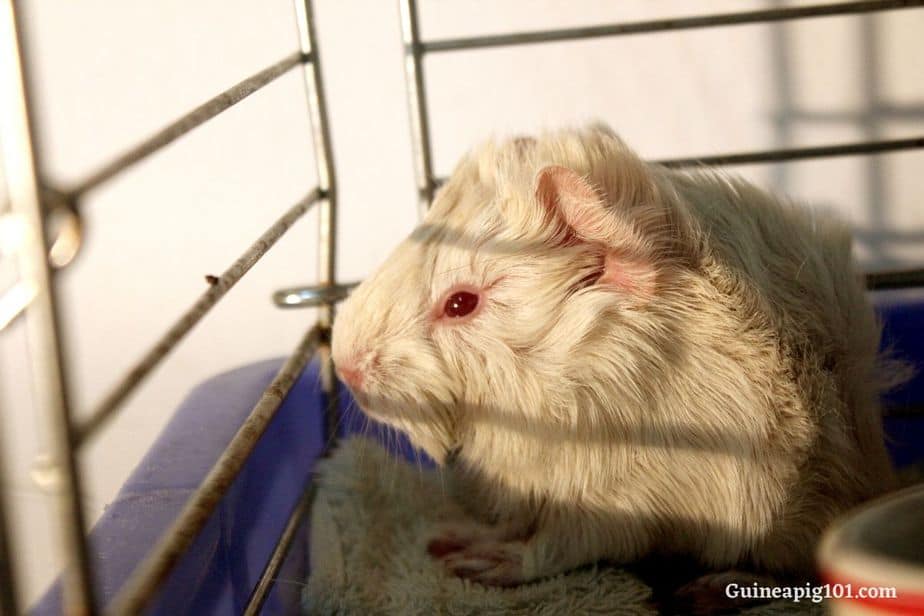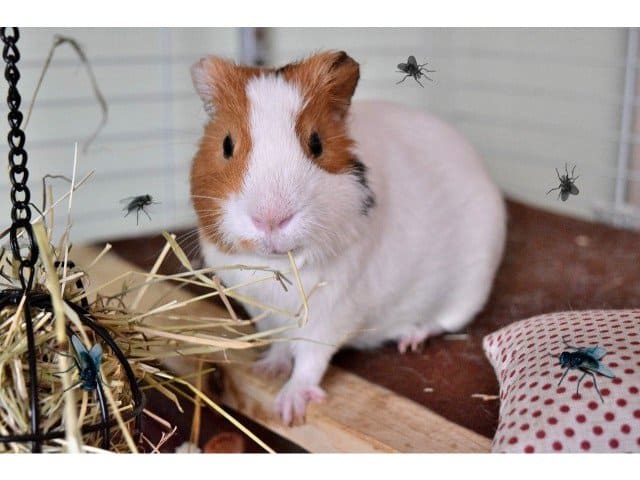Nothing can be worse than flies in your house, especially when they are surrounding your guinea pigs. But why do the flies do so? Do guinea pigs attract flies?
Flystrike is a severe threat to our guinea pigs. Flies are attracted to the animal manure where they can lay eggs and breed. Guinea pigs suffering from wet bottom or skin cracks are also their primary targets. Within 2 hours, the eggs will hatch into larvae and start feeding on your guinea pigs.
If you are keeping your guinea pigs in an outside hutch that is not maintained correctly, then it might be a significant attractant as flies like damp and smelling conditions.
Apart from those stale veggies and food can also attract fruit flies if not removed on time.
Flies can be annoying and dangerous at the same time. Some flies can bite your guinea pigs and feed on them. I know it might sound a little weird, but they do bite our guinea pigs.
They look for an area with less fur, like eyes, ears, anus, etc. They may even attack the area with cracked or dried skin. Flies like damp and smelly conditions, and if your cage has favorable conditions, then this can be another reason why flies are attracted.
Whatever the reason might be, it must be our utmost priority to get rid of flies from the cage area as well as our home itself. Flies possess a lot of threats to our guinea pigs.
So, to get rid of the flies first, we need to understand why are flies attracted to guinea pigs. Then we will work on fixing the issues and preventing the flies from coming back.
Why do guinea pigs attract flies?

There can be numerous reasons that can attract flies. It is doubtful that guinea pigs by themselves attract flies, as it is only possible if they are ill.
In most cases, flies are attracted by the enclosure of the guinea pigs. Let us check out a few common reasons which attract flies towards guinea pigs:
Cracked or dry skin
Guinea pigs suffering from fungal infection usually have a dry and cracked skin to which flies are attracted to.
They attack those dry areas and bite our guinea pigs to feed themselves. So, we need to make sure we keep our guinea pigs safe, especially when they are ill.
Wet bottom & fur:
If your guinea pigs are suffering from diarrhea or they don’t have absorbent bedding, and their hair is getting wet due to their own pee, then this can be a significant attractant to flies.
Flies look for such places to lay their eggs and can even lay eggs over your guinea pig’s bodies. These eggs will further develop into a maggot, which will feed on your guinea pigs.
Sometimes, such situations can be nasty, and we will need to visit a vet to make sure our guinea pigs recover soon.
Unmaintained cage or litterbox:
If you don’t spot clean the cage daily or do the weekly maintenance properly, then your guinea pigs cage might attract lots of flies.
Animals manure is an excellent breeding ground for flies, and your guinea pigs enclosure will likely get flystrike. You need to keep the cage clean and avoid any odor to prevent flies.
Stale Vegetables:
Stale or uneaten vegetables and fruits lying in the cage is one of the significant attractants of flies.
Whenever you serve your guinea pigs with fresh veggies or fruits, always make sure you remove any uneaten parts within a few hours of serving.
If the food is lying around for several hours, then it is an open invitation for fruit flies to come by.
Wet bedding:
Wet bedding can be another significant attractant of flystrike. If you are using hay or any similar bedding which gets soaked either due to pee or due to water leakage from the bottles( A common cause), then the flies are going to come to breed there.
Flies love such an environment to live and breed, and it is a wise decision to use good quality bedding in the cage to prevent such situations.
Damp and smelly hutches:
If you are keeping your guinea pigs outside in a hutch, then you probably know by now that how difficult can it be to keep the cage maintained.
Keeping up with maintenance can be tough for most owners, and as a result, the hutches are damp and smelly due to pee and poop of your guinea pigs.
Being outside with no protection, along with such maintenance, is undoubtedly going to give lots of flies an open invitation to strike.
What types of flies can guinea pigs attract?
House flies, and fruit flies are some common types of flies that can get attracted to your guinea pigs.
Although many other bugs like gnats, mosquitoes, etc can get attracted to your guinea pigs, but flies are some of the most common ones.
Please note: Both fruit flies and common houseflies possess equal threats to your guinea pigs and must be dealt with accordingly.
Are flies attracted to hay?
Yes, if the hay is moist or wet due to urine or water, then flies can definitely be attracted to them. Always make sure you use a hay rack for serving hay to your guinea pigs.
It will help in preventing such situations. Also, using hay for bedding can be a cheap alternative but is definitely not recommended.
So, go for a super absorbent good quality bedding for your guinea pigs enclosure.
How do I get rid of flies around my guinea pig cage?
Getting rid of flies around your guinea pig’s cage can be a pain. As guinea pigs have a strong sense of smell, you cannot use strong pest control sprays and chemicals. You will need to work your way around, and today I am going to help you through it.
Keep the cage clean:
Keeping your guinea pigs cage clean is the topmost priority to drive the flies away. Flies are attracted to the dirt, litter, and leftover food the most. Deep cleaning of the cage is a must to drive the flies away.
You can use some natural guinea pig safe cleaner or regular vinegar and water to clean the pen properly. If you clean the cage regularly, then the flies will definitely leave your cage alone.
You can learn in-depth about how to clean your guinea pig’s cage and get rid of the foul smell from our article for more info.
Change bedding regularly:
Beddings are an essential part of the guinea pig’s enclosure. Beddings absorb the pee and other waste and help in keeping the cage clean. However, with time, the bedding starts getting bad and needs a change.
If you continue to use soiled bedding, then flies will definitely get attracted. Thus, getting rid of old bedding or washing and using the old bedding is in the priority list to get rid of flies.
Remember, flies don’t like clean and tidy environments.
Using good quality leak-proof water bottles:
Leaky water bottles are one of the major culprits that lead to flystrike. Some water bottles leak overnight and soak the bedding wet. If you don’t take care of the situation at the right time, then flystrike is inevitable.
Using a good quality leak proof water bottle is a must for guinea pigs cage. Also, some people use water bowls instead of bottles.
I would definitely recommend to avoid it as the chances of tipping over is quite high. Also, stagnant open water can be a breeding ground for lots of bugs.
Placing the cage in a well-ventilated area:
Placing the cage in a well-ventilated area is also helpful in getting rid of flies. The waste buildup also releases ammonia in the air, which is a significant fly attractant.
Proper ventilation will take the harmful gas away, thus reducing the flies from the cage area.
Removing any leftover food:
Waste food leftover often starts decomposing quickly. It is strongly recommended to remove any uneaten food from your guinea pigs cage within a few hours itself.
If the food remains for quite some time, then the flies are sure to come by as well. Removing any uneaten food will also help in getting rid of flies from the area.
If you have any garbage bin, then it will be ideal for removing it from the area as well.
Using the screen on the windows:
Using fly screens on windows is ideal for preventing any further flystrike. If you leave any windows open for ventilation, then make sure there is a flyscreen attached to it.
Open windows without screens can definitely attract a lot of flies towards the guinea pigs cage.
Using flystrike protector:
If your guinea pig had flystrike try using some flystrike protector that will get rid of any flies stuck on their body.
However, if the flies have already laid eggs that have grown to become maggots, then visiting a vet is recommended to get rid of the same.
Using fly traps:
Flytraps are yet another efficient way to get rid of flies from the cage area. You can use natural, and chemical-free fly traps to get rid of any flies from the area.
Although many people think that’s a stupid idea; trust me, you will be surprised when you see the results. So, go ahead and give it a try.
It is always a good idea to prevent the flystrike from happening rather than dealing with it later. Regular cage maintenance, using quality bedding, and maintaining a suitable living environment all around the house can help you prevent these sorts of situations altogether.
Conclusion
Do guinea pigs attract flies? Yes, they definitely do attract flies. The environment where the guinea pig lives are one of the significant causes of flystrike rather than the guinea pig themselves.
If you don’t take preventive measures, then your guinea pig will get attacked by those nasty flies and bear in mind those flies can be a life threat to guinea pigs as well.
So, try the steps we had discussed earlier and get rid of flies from around your guinea pigs to keep your guinea pigs safe and sound.
Related Questions:
Can flies lay eggs on guinea pigs?
Yes, flies can definitely lay eggs on guinea pigs. The area around the anus is pretty vulnerable to flies as guinea pigs usually have a moist bottom due to regular pee and poop.
Can flies hurt guinea pigs?
Yes, flies can hurt guinea pigs. In fact, flies lay eggs, which then hatches into maggots and starts feeding upon your guinea pigs. If not taken care of on time, then these larvae can harm a guinea pig pretty quickly.
Sources: ASTMH, ACS PUBLICATION, OXFORD ACADEMICS, CAB DIRECT
